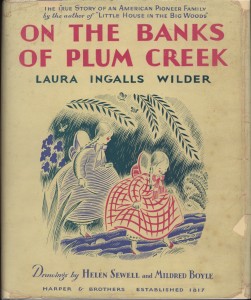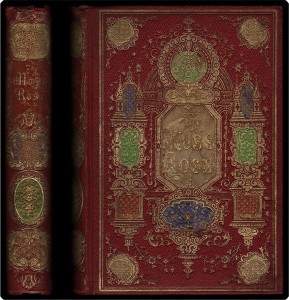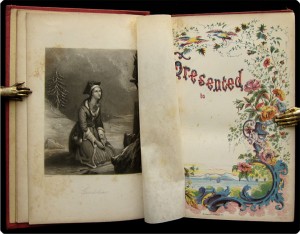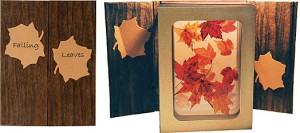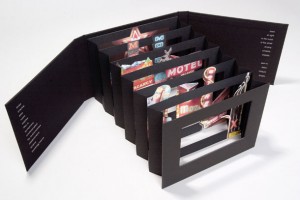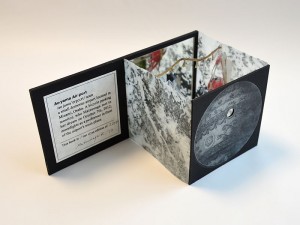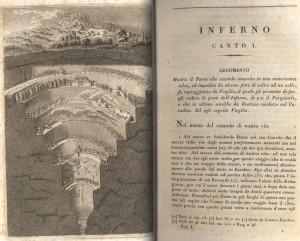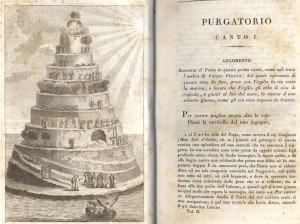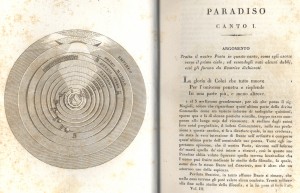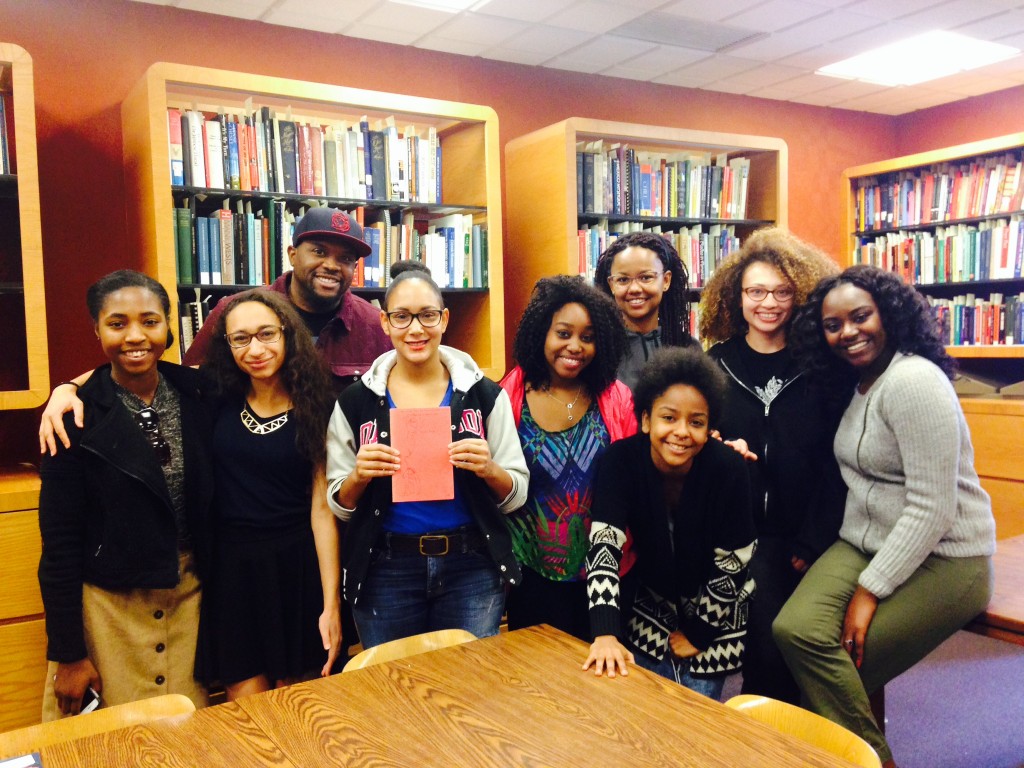 In December of 2015, Idris Goodwin directed a sold-out production of Ntozake Shange’s choreopoem For Colored Girls Who Have Considered Suicide … When the Rainbow is Enuf at Colorado College. He and the cast (Alexandra Farr, Lyric Jackson, Jazlyn Andrews, Jaiel Mitchell, Justice Miles, Brittany Comancho, Deaira Cooper, and Erica Willard) stopped by Special Collections last week to take a look at a first edition of the book, which was first published in 1975 by Shameless Hussy Press in 1975.
In December of 2015, Idris Goodwin directed a sold-out production of Ntozake Shange’s choreopoem For Colored Girls Who Have Considered Suicide … When the Rainbow is Enuf at Colorado College. He and the cast (Alexandra Farr, Lyric Jackson, Jazlyn Andrews, Jaiel Mitchell, Justice Miles, Brittany Comancho, Deaira Cooper, and Erica Willard) stopped by Special Collections last week to take a look at a first edition of the book, which was first published in 1975 by Shameless Hussy Press in 1975.
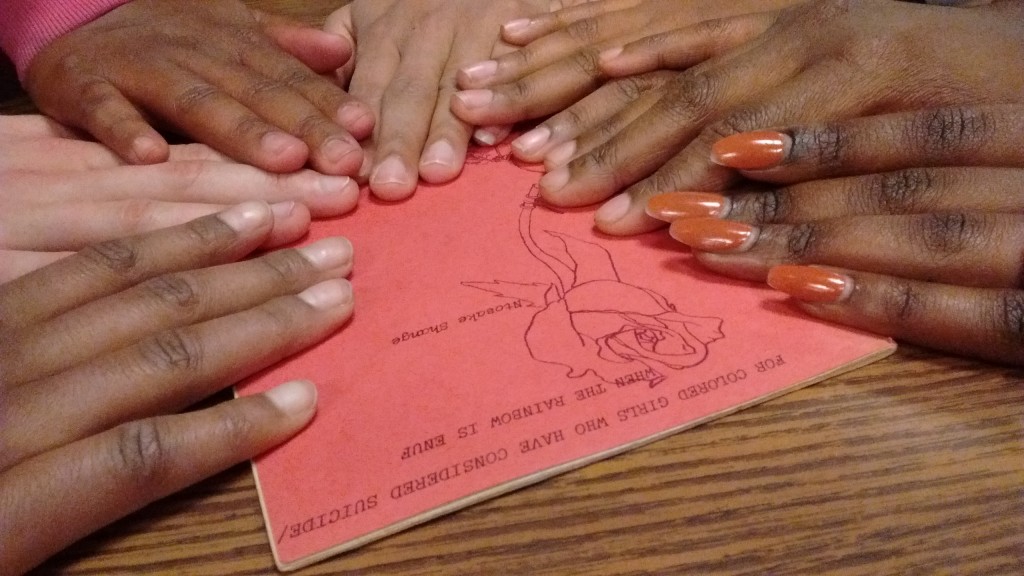
W.E.S. gift (part 5)
This is the fifth and final report on how we spent the $10,000 gift we received from the Woman’s Educational Society:
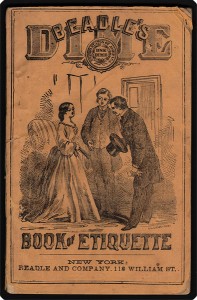 Irwin P. Beadle. Beadle’s Dime Book of Etiquette: A Practical Guide to Good Breeding. New York: Beadle & Adams, [ca. 1890]. Revised and enlarged edition. A manual for behaving properly in society, useful for understanding the history of gender. We learn that “some men have a mania for Greek and Latin quotations; this is a peculiarity to be avoided. Nothing is more wearisome than pedantry.” Ladies, on the other hand, should “always maintain a dignity of character, and never condescend to trifle” in conversation.
Irwin P. Beadle. Beadle’s Dime Book of Etiquette: A Practical Guide to Good Breeding. New York: Beadle & Adams, [ca. 1890]. Revised and enlarged edition. A manual for behaving properly in society, useful for understanding the history of gender. We learn that “some men have a mania for Greek and Latin quotations; this is a peculiarity to be avoided. Nothing is more wearisome than pedantry.” Ladies, on the other hand, should “always maintain a dignity of character, and never condescend to trifle” in conversation.
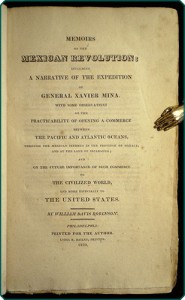 Robinson, William Davis. Memoirs of the Mexican Revolution: Including a Narrative of the Expedition of General Xavier Mina. Philadelphia: Lydia R. Bailey, 1820. First edition, edges untrimmed. Lydia R. Bailey (1779-1869) was the first woman printer in Philadelphia, inheriting her husband’s floundering press in 1808. (She was followed soon after by Jane Aitken (1810) and Ann Cochran (1812). Under Bailey’s management, the press thrived for five decades. At its peak, it employed forty workers and was one of the largest printing establishments in the city. (For more information, see Loena M. Hudak’s Early American Women Printers and Publishers, Scarecrow Press, 1978.)
Robinson, William Davis. Memoirs of the Mexican Revolution: Including a Narrative of the Expedition of General Xavier Mina. Philadelphia: Lydia R. Bailey, 1820. First edition, edges untrimmed. Lydia R. Bailey (1779-1869) was the first woman printer in Philadelphia, inheriting her husband’s floundering press in 1808. (She was followed soon after by Jane Aitken (1810) and Ann Cochran (1812). Under Bailey’s management, the press thrived for five decades. At its peak, it employed forty workers and was one of the largest printing establishments in the city. (For more information, see Loena M. Hudak’s Early American Women Printers and Publishers, Scarecrow Press, 1978.)
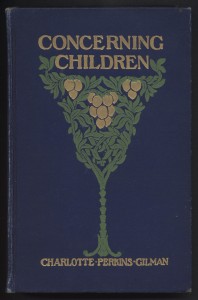 Charlotte Perkins Gilman. Concerning Children. Boston: Small, Maynard, 1900. This is the fourth book by Gilman, best known for her short story “The Yellow Wallpaper” and her novel Herland. In it, she argues that mothers and children would both benefit from group childcare centers. The decorative binding, signed “MLP,” is by Marion Louise Peabody.
Charlotte Perkins Gilman. Concerning Children. Boston: Small, Maynard, 1900. This is the fourth book by Gilman, best known for her short story “The Yellow Wallpaper” and her novel Herland. In it, she argues that mothers and children would both benefit from group childcare centers. The decorative binding, signed “MLP,” is by Marion Louise Peabody.
THANK YOU, W.E.S.!!!
W.E.S. gift (part 4)
We continue our report on how we spent the $10,000 gift we received from the Woman’s Educational Society, celebrating several more works of literature by women authors.
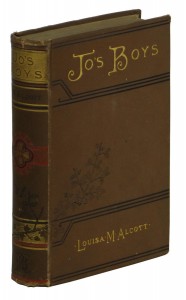 Louisa May Alcott. Jo’s Boys. Boston: Roberts Brothers, 1886. First edition, first state (text block measures 1 1/16 inches), in brown cloth. Following up on Little Women and Little Men, this is Alcott’s final book featuring Jo March.
Louisa May Alcott. Jo’s Boys. Boston: Roberts Brothers, 1886. First edition, first state (text block measures 1 1/16 inches), in brown cloth. Following up on Little Women and Little Men, this is Alcott’s final book featuring Jo March.![]()
Jane Austen. Persuasion. Westport, Connecticut: The Limited Editions Club, 1977. With an introduction by Louis Auchincloss and illustrations by Tony Buonpastore. Designed by Robert L. Dothard and printed at the Stinehour Press. Copy 1009 of 1600 signed by the artist.
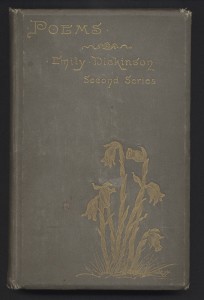 Emily Dickinson. Poems: Second Series. Boston: Roberts Brothers, 1892. First Edition, early printing. (Special Collections owns the preeminent collection of the papers of Dickinson’s childhood friend, the writer Helen Hunt Jackson. Until now, however, we have never owned any 19th century editions of Dickinson’s collections of poetry.)
Emily Dickinson. Poems: Second Series. Boston: Roberts Brothers, 1892. First Edition, early printing. (Special Collections owns the preeminent collection of the papers of Dickinson’s childhood friend, the writer Helen Hunt Jackson. Until now, however, we have never owned any 19th century editions of Dickinson’s collections of poetry.)
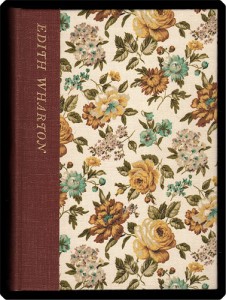 Edith Wharton. The Age of Innocence. Avon, Connecticut: The Limited Editions Club, 1973. With an introduction by R.W.B. Lewis and illustrations by Lawrence Beall Smith. Designed by Philip Grushkin and printed at the Press of the Archer. Copy 389 of 2000 signed by the artist.
Edith Wharton. The Age of Innocence. Avon, Connecticut: The Limited Editions Club, 1973. With an introduction by R.W.B. Lewis and illustrations by Lawrence Beall Smith. Designed by Philip Grushkin and printed at the Press of the Archer. Copy 389 of 2000 signed by the artist.
Laura Ingalls Wilder. On the Banks of Plum Creek. Illustrated by Helen Sewell and Mildred Boyle. New York: Harper & Brothers, c. 1937. Ninth edition, in dust jacket.
W.E.S. gift (part 3)
We continue our report on how we spent the $10,000 gift we received from the Woman’s Educational Society, celebrating several works of literature by women authors. (More in the next post.)
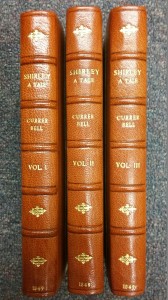 Charlotte Brontë (publishing as Currer Bell). Shirley. London: Smith, Elder, and Co., 1849. First edition. “Triple decker” (three volume set), beautifully re-bound in half leather.
Charlotte Brontë (publishing as Currer Bell). Shirley. London: Smith, Elder, and Co., 1849. First edition. “Triple decker” (three volume set), beautifully re-bound in half leather.
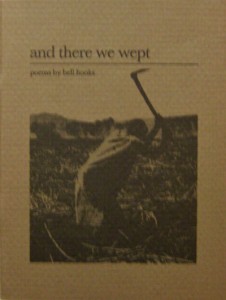 bell hooks. And There We Wept. Los Angeles: Published by Gloria Watkins / Golemics, 1978. This unpaginated poetry chapbook is bell hooks’s first book. Her next book, Ain’t I a Woman, addresses problems of race and class within feminism.
bell hooks. And There We Wept. Los Angeles: Published by Gloria Watkins / Golemics, 1978. This unpaginated poetry chapbook is bell hooks’s first book. Her next book, Ain’t I a Woman, addresses problems of race and class within feminism.
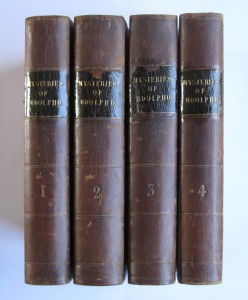 Ann Radcliffe. The Mysteries of Udolpho: A Romance. London: G.G. and J. Robinson, 1794. Second edition, in four volumes. (This second edition appeared the same year as the first.) Bound in half-calf over marbled boards. Radcliffe is widely considered to be the mother of the Gothic novel, and Jane Austen references Udolpho repeatedly in her Gothic satire, Northanger Abbey.
Ann Radcliffe. The Mysteries of Udolpho: A Romance. London: G.G. and J. Robinson, 1794. Second edition, in four volumes. (This second edition appeared the same year as the first.) Bound in half-calf over marbled boards. Radcliffe is widely considered to be the mother of the Gothic novel, and Jane Austen references Udolpho repeatedly in her Gothic satire, Northanger Abbey.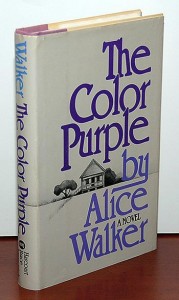
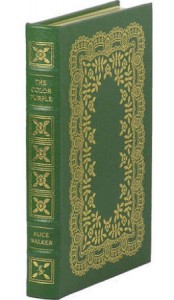
Alice Walker. The Color Purple. Illustrated by Brad Teare. Norwalk, Connecticut: Easton Press, 2000. Originally published in 1982, Walker’s novel has been made into a film, a Broadway musical, and this “collector’s edition,” part of the subscription series “Great Books of the 20th Century.” We look forward to comparing this edition (green with gilt) with the first edition (in jacket).
The Moss Rose. New York: Leavitt & Allen, [ca. 1855]. Gift book containing Mary Shelley’s “Sisters of Albano” along with stories and poems by many other women authors. Decorative binding, all edges gilt.
W.E.S. gift (part 2)
We continue our report on how we spent the $10,000 gift we received from the Woman’s Educational Society, celebrating three foundational feminist works newly acquired for Special Collections:
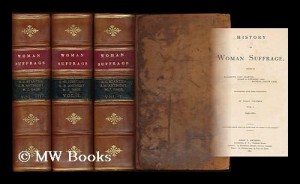 Elizabeth Cady Stanton, Susan B. Anthony, and Matilda Joslyn Gage. History of Woman Suffrage. Rochester, New York: Charles Mann, 1887. Three volumes (volume 1: 1848-1861; volume 2: 1861-1876; volume 3: 1876-1885). A comprehensive overview of the woman suffrage movement by those who led it.
Elizabeth Cady Stanton, Susan B. Anthony, and Matilda Joslyn Gage. History of Woman Suffrage. Rochester, New York: Charles Mann, 1887. Three volumes (volume 1: 1848-1861; volume 2: 1861-1876; volume 3: 1876-1885). A comprehensive overview of the woman suffrage movement by those who led it.
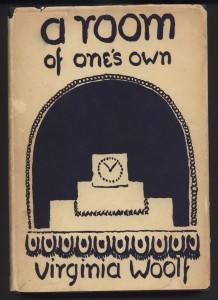
Virginia Woolf. A Room of One’s Own. New York: Harcourt Brace, 1929. In dust jacket designed by Vanessa Bell. First American edition, simultaneous with British edition. 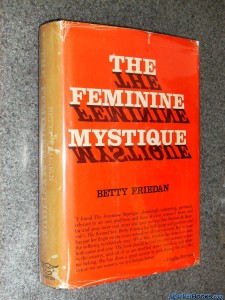
Betty Friedan. The Feminine Mystique. New York: W.W. Norton & Co., 1963. First edition, in jacket. Friedan researches and describes what she calls “the problem that has no name” — the dissatisfaction and depression of materially-comfortable American housewives in the 1950s.
W.E.S. gift of $10,000 (part 1)
The Woman’s Educational Society of Colorado College has a long history of supporting Special Collections. In the 1960s and 70s, the WES provided furnishings for our reading room; we still use these shelves and drawers even now, though some of them have become a bit stubborn and difficult with age (dare I say … like all of us?).
This year, the WES decided to make a different kind of long-term gift to Special Collections: $10,000 for the department to spend “for the purpose of enhancing the college curriculum by acquiring significant books and documents that focus on women’s history and women’s contributions to society.”
I shall be reporting over the next few weeks on acquisitions made with this generous gift, starting with an important 16th century edition of a book on women’s health:
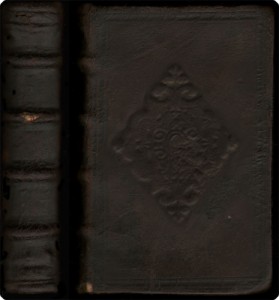
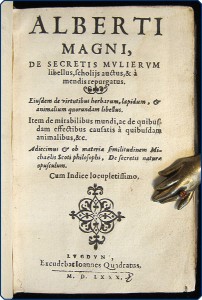 Magnus Albertus (attrib.). De Secretis Mulierum Libellus… [The Secrets of Women.] Lugduni [Lyon, France]: Ioannes Quadratus, 1580. Small leatherbound book in Latin on topics such as menstruation, sexual reproduction, and pregnancy. Extremely rare: this is one of only three known copies in U.S. libraries and fewer than ten worldwide. A portion of Helen Rodnite Lemay’s 1992 English translation of the text is available from Google Books. 21st century readers beware: you won’t find a lot of reliable medical information in this book, which is based on 13th and 14th century manuscripts attributed to Magnus Albertus but probably actually produced by multiple (male) authors.
Magnus Albertus (attrib.). De Secretis Mulierum Libellus… [The Secrets of Women.] Lugduni [Lyon, France]: Ioannes Quadratus, 1580. Small leatherbound book in Latin on topics such as menstruation, sexual reproduction, and pregnancy. Extremely rare: this is one of only three known copies in U.S. libraries and fewer than ten worldwide. A portion of Helen Rodnite Lemay’s 1992 English translation of the text is available from Google Books. 21st century readers beware: you won’t find a lot of reliable medical information in this book, which is based on 13th and 14th century manuscripts attributed to Magnus Albertus but probably actually produced by multiple (male) authors.
We also purchased a much more common (and affordable) book on the same topic:
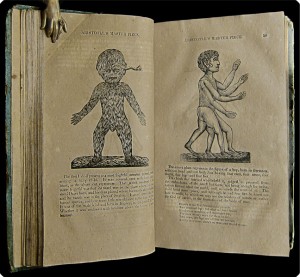 Aristotle (pseud.). The works of Aristotle, the famous philosopher, in four parts. Containing. I. His complete masterpiece; displaying the secrets of nature in the generation of man … 2. His experienced midwife; absolutely necessary for surgeons, midwives, nurses and child bearing women. 3. His book of problems, containing various questions and answers, relative to the state of man’s body. 4. His last legacy; unfolding the secrets of nature respecting the generation of man. New-England: Printed for the publishers, 1831. Colloquially known as “Aristotle’s Masterpiece” (so one could request it in a bookshop without embarrassment), versions of this text were first published in the late 16th century. Nevertheless, the book contains even more misinformation than The Secrets of Women, with illustrations that only compound the problem. Apparently, for example, if a woman thinks bad thoughts while she is pregnant, her baby may be born covered in fur.
Aristotle (pseud.). The works of Aristotle, the famous philosopher, in four parts. Containing. I. His complete masterpiece; displaying the secrets of nature in the generation of man … 2. His experienced midwife; absolutely necessary for surgeons, midwives, nurses and child bearing women. 3. His book of problems, containing various questions and answers, relative to the state of man’s body. 4. His last legacy; unfolding the secrets of nature respecting the generation of man. New-England: Printed for the publishers, 1831. Colloquially known as “Aristotle’s Masterpiece” (so one could request it in a bookshop without embarrassment), versions of this text were first published in the late 16th century. Nevertheless, the book contains even more misinformation than The Secrets of Women, with illustrations that only compound the problem. Apparently, for example, if a woman thinks bad thoughts while she is pregnant, her baby may be born covered in fur.
Soviet magazine by Rodchenko and Gorki
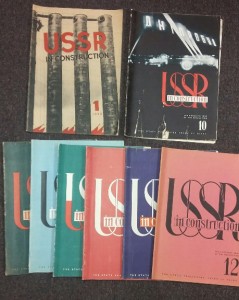 Special Collections has been receiving a number of unusual and wonderful books from the Colorado Springs Fine Arts Center, which donated its library to Colorado College last year. Special Collections Cataloger Amy Brooks draws our attention to one of these recent acquisitions, several 1932 issues of The USSR in Construction, a monthly magazine. You can read all about it here and see images here.
Special Collections has been receiving a number of unusual and wonderful books from the Colorado Springs Fine Arts Center, which donated its library to Colorado College last year. Special Collections Cataloger Amy Brooks draws our attention to one of these recent acquisitions, several 1932 issues of The USSR in Construction, a monthly magazine. You can read all about it here and see images here.
According to Alexandre Antique Prints, Maps & Books, Toronto, Canada, 2015, “…the real beauty of these magazines was not in ideology but in artistic design. [Alexander] Rodchenko and [Maxim] Gorki were avant-garde specialists and their methods of printing and layout are legendary. The magazine has lived on to become a fascinating example of Soviet propaganda; Stalin’s attempt to show the world that his rebuild was sustainable.”
tunnel books at CC Special Collections
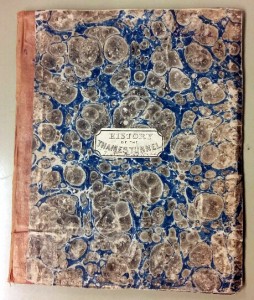
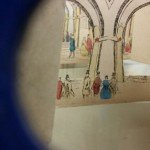 Tunnel books have been made and sold since the mid-18th century in Europe. The earliest one in CC Special Collections, History of the Thames Tunnel (1861), was sold to tourists in England, as was our next-earliest, The Picture-Post Coronation Peep-Show Book (1953).
Tunnel books have been made and sold since the mid-18th century in Europe. The earliest one in CC Special Collections, History of the Thames Tunnel (1861), was sold to tourists in England, as was our next-earliest, The Picture-Post Coronation Peep-Show Book (1953).
Our copy of the Thames Tunnel book is quite worn, suggesting that many people looked through its eye-holes over the years before it came to the library.
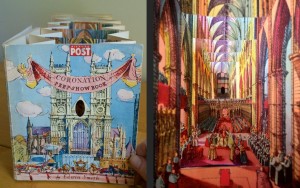 Our Coronation book, on the other hand, was purchased in kit form and never put together. Luckily, the Journal of Wild Culture offers a photo essay showing what the book looks like from various angles.
Our Coronation book, on the other hand, was purchased in kit form and never put together. Luckily, the Journal of Wild Culture offers a photo essay showing what the book looks like from various angles.
Our other tunnel books are artists’ books made in the last two decades. Edward H. Hutchins’s Arizona Wildlife (1999) is made from picture postcards.
Jill Timm’s Falling Leaves (2006).
Laura Russell’s Nocturne (2004) shows a fanciful version of the neon signs on Colfax Avenue in Denver and is a favorite among CC students.
Kyoko Matsunaga’s Aoyama Airport (2013).
For a good overview of tunnel books, see Jean-Charles Trebbi’s The Art of Pop-Up: The Magical World of Three-Dimensional Books (Promo Press, 2012), available at many libraries.
a donation from Professor Fuller
Tim Fuller, a member of the CC political science department since 1965, donated two rare and valuable books to Special Collections this month, both by Richard Hooker.
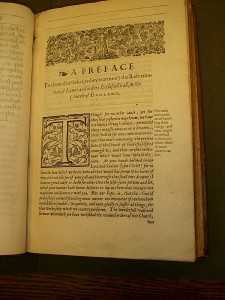 Professor Fuller writes: “My primary field of research is in British political thought since the English Reformation. Richard Hooker was considered, and many still consider him, the greatest Anglican theologian. In the turmoil of the 16th century, Hooker defended the natural law tradition (he is sometimes referred to as the English Thomas Aquinas). He wrote against the “religious enthusiasm” of the Puritans, in defense of what became known as the Elizabethan Settlement which established Anglicanism as we have since known it. His great work, Laws of Ecclesiastical Politie, I acquired in two versions:
Professor Fuller writes: “My primary field of research is in British political thought since the English Reformation. Richard Hooker was considered, and many still consider him, the greatest Anglican theologian. In the turmoil of the 16th century, Hooker defended the natural law tradition (he is sometimes referred to as the English Thomas Aquinas). He wrote against the “religious enthusiasm” of the Puritans, in defense of what became known as the Elizabethan Settlement which established Anglicanism as we have since known it. His great work, Laws of Ecclesiastical Politie, I acquired in two versions: 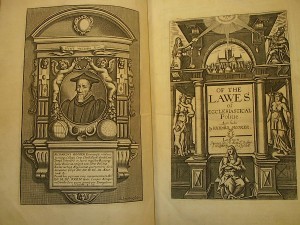 the 1705 folio [below] in an Oxford bookshop in 1989, and the 1617 edition [above] from a Connecticut book dealer about 10 years later. The 1705 is the complete work with a famous biographical introduction by Isaac Walton, the version used today by students of Hooker’s thought. The complete work was not published until the 1660s. The 1617 is roughly the fourth edition (there are several versions of it) which published through only the fifth book (of what was ultimately eight books), but is historically important.”
the 1705 folio [below] in an Oxford bookshop in 1989, and the 1617 edition [above] from a Connecticut book dealer about 10 years later. The 1705 is the complete work with a famous biographical introduction by Isaac Walton, the version used today by students of Hooker’s thought. The complete work was not published until the 1660s. The 1617 is roughly the fourth edition (there are several versions of it) which published through only the fifth book (of what was ultimately eight books), but is historically important.”
We are very pleased to have these at CC!
Library record for 1617 edition: https://tiger.coloradocollege.edu/record=b2370155~S5
Library record for 1705 edition: https://tiger.coloradocollege.edu/record=b2370143~S5
Dante again!
Special Collections seems to be making a habit of acquiring editions of Dante’s Commedia. Maybe this is because it was a hugely popular book in the early years of printing history, and it helps that Re Evitt teaches a whole course at CC on the text.
Our newest Dante is a five volume edition published in Padua in 1822 with the commentary of Baldassare Lombardi. The frontispiece illustrations in volumes 1, 2, and 3 will knock your socks off. Just look at ’em!

